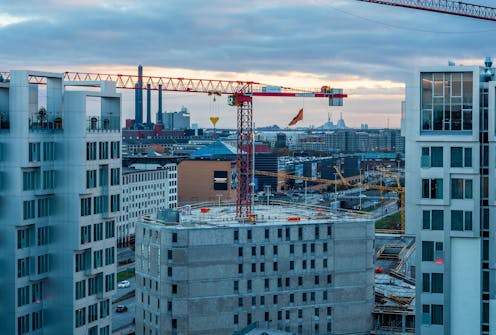Our buildings are driving us closer to 'climate hell' – how do we get back on course to net zero?
- Written by Anna Hurlimann, Associate Professor in Urban Planning, The University of Melbourne

More and more of the world’s people are feeling the impacts of climate change. As United Nations Secretary-General António Guterres said when COP27 opened this week: “We are on a highway to climate hell with our foot on the accelerator.”
Much of the weight on the accelerator is coming from the construction and building sector. Accounting for 37% of global carbon dioxide emissions, the built environment is a major part of the climate change problem. That also means it can and must be a key part of the solution.
The United Nations Environment Programme (UNEP) has just released its 2022 Global Status Report for Buildings and Construction at COP27. Its findings are alarming.
The sector’s energy consumption and emissions have rebounded from the COVID pandemic to an all-time high. Emissions are 2% higher than the previous peak in 2019.
The report says the reasons include revival of construction activity suppressed during lockdowns, and more intensive use of existing buildings.
In 2021, buildings accounted for more than 34% of the world’s total energy demand. This figure includes embodied energy that goes into construction materials and processes, and operational energy that goes into running buildings. The sector produced about 37% of CO₂ emissions.
The gap between the sector’s performance and what needs to be done to achieve decarbonisation by 2050 is widening – despite a 16% increase in investments in building energy efficiency from 2020 to 2021.
How do we measure progress?
The Paris Agreement seeks to avoid catastrophic climate change by limiting global warming to 1.5℃ and no more than 2℃. The Human Settlements Pathway of the Marrakech Partnership for Global Climate Action identifies two objectives which are building momentum across the sector:
by 2030, halve built environment emissions, with 100% of new buildings to be net-zero carbon in operation
by 2050, all new and existing built assets must be net zero across their whole life cycle, including both embodied and operational emissions.
To track the decarbonisation progress, the Global Buildings Climate Tracker has mapped a direct reference path to a target of zero-carbon building stock in 2050. The tracker has seven components:
3 impact elements:
4 action elements:
investing in energy efficiency
green building certification
nationally determined contributions to include building sector action
building codes and regulations.
So why is the sector going backwards?
At first glance, the report offers some good news when comparing the 2021 trends to the 2015 baseline data. However, the overriding change is gross floor area, which has increased by 11% – 24 billion square metres – since 2015. This growth in construction, which is predicted to continue beyond 2050, is outweighing progress in other areas.
Read more: A green trifecta: how a concrete alternative can cut emissions, resource use and waste
In addition, energy intensity has stagnated, falling by only 0.7%. Three-quarters of countries still do not have mandatory energy-efficiency standards for all building types. While an increasing number mention buildings in their nationally determined contributions, many still don’t have detailed plans for achieving net-zero emissions from the sector by 2050.
Global buildings and construction trends, 2015 and 2021





